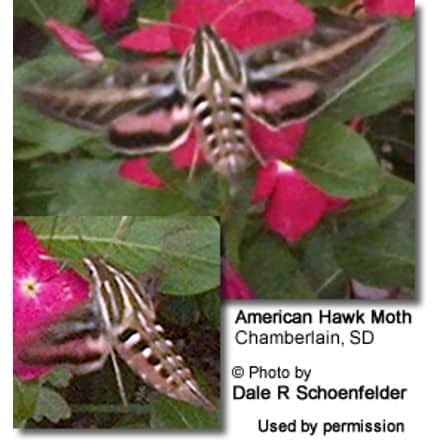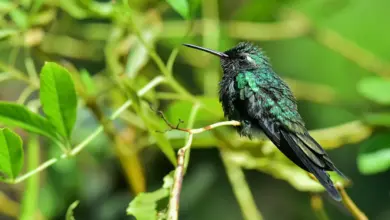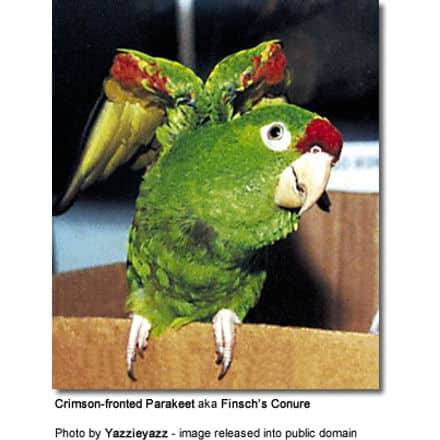Hummingbirds found in Alabama, USA
Hummingbirds found in the USA (by U.S. State) … Canada … Mexico … Puerto Rico … Jamaica … Honduras
Hummingbird Information … Hummingbird Species Photo Gallery
The following hummingbird species have been reported in Alabama (with photos and ID assistance)
Migrating hummingbirds usually arrive in Alabama around mid-March. Some rare WHITE Hummingbirds (Leucistic / Albino) have also been reported in this state.
Identification of many hummingbird species is often most easily done by the males’ flashy, iridescent throat patches, which range from orange, red, purple, green, blue. These patches may be restricted to only the throat or in some species may extend over the crown or even over most of the head. However, in poor light conditions, these color patches may simply look greyish/black, which makes identification more difficult. Females and juveniles of the different species often look alike, but some physical clues can often be found.
Ruby-throated Hummingbirds (Archilochus colubris) – Common native breeders – Ruby-throats arrive in mid-March (earlier on coast). They depart in October. Migrating males are usually the first to arrive and the first to depart. The females and the young usually follow about two weeks later.
The male has a ruby-red throat, a white collar, an emerald green back and a forked tail.
The female has a green back and tail feathers that are banded white, black and grey-green.
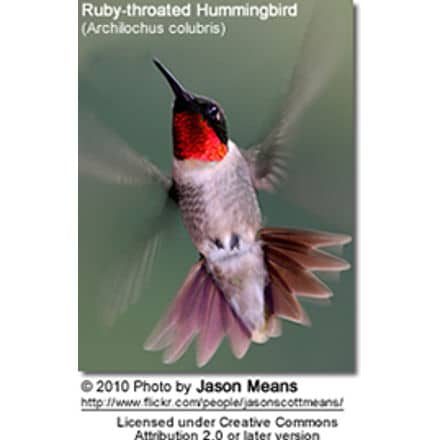
Rufous Hummingbirds (Selasphorus rufus) – Rare to uncommon in winter, spring and fall in Gulf Coast region. In other regions, rare in winter, spring and fall. They are usually found in gardens and at hummingbird feeders.
These hummingbirds are usually found in gardens and at feeders. These birds are fearless, and are known for chasing away other hummingbirds and even larger birds, or rodents away from their favorite nectar feeders and flowers.
Males can easily be identified by their glossy orange-red throats.
Females have whitish, speckled throats, green backs and crowns, and rufous, white-tipped tail feathers.
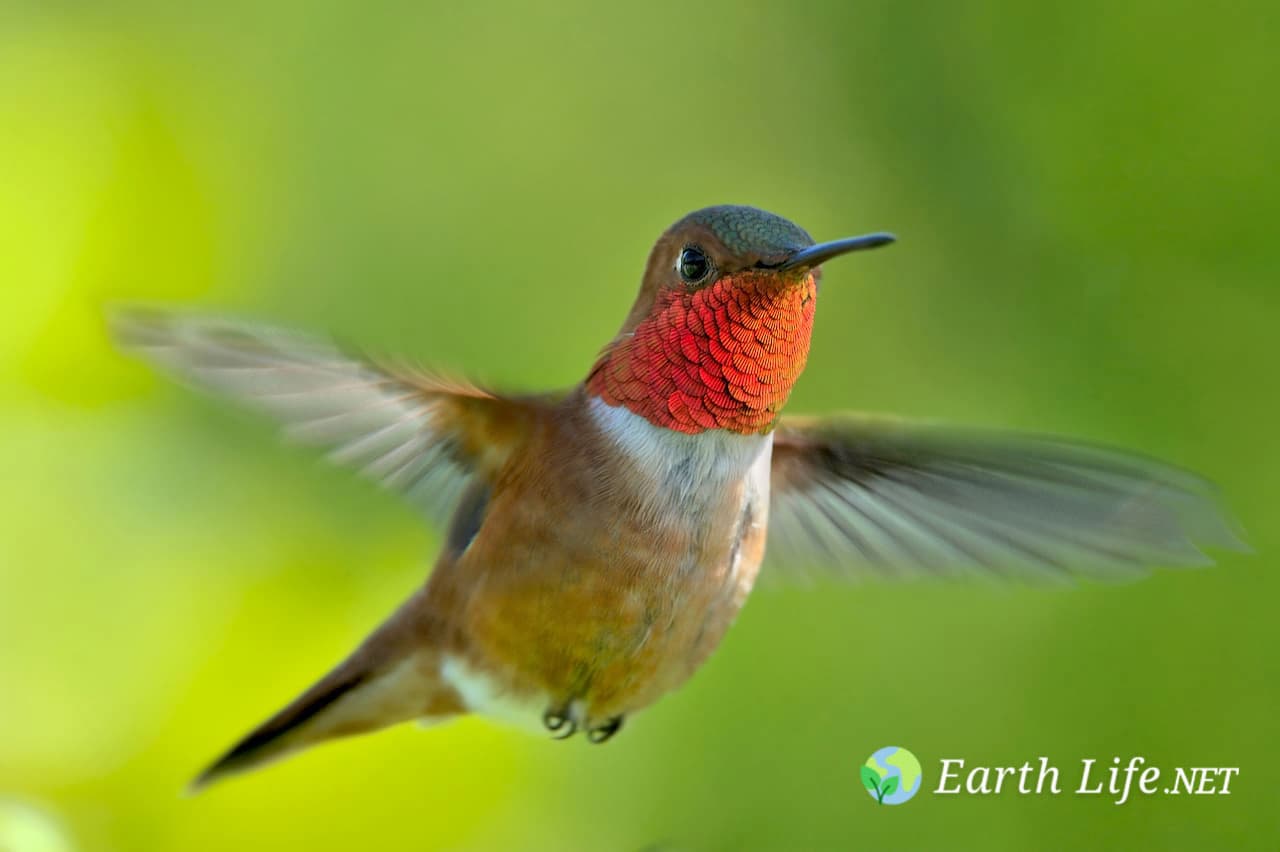
Rufous Hummingbird versus the similar Ruby-throated Hummingbird (Identification)
Blue-throated Hummingbirds (Lampornis clemenciae) – Common in spring, summer and fall. Rare in winter in the Gulf Coast regions. In other regions, common in spring, summer and fall. Inhabits woodlands
The upper plumage is dull green, fading to a medium grey on the underside. It has white stripes behind the eyes and a narrower stripe extending backward from the corner of its relatively short bill, next to a blackish cheek patch.
The male can be identified by the iridescent blue throat patch (gorget), which may appear black or grey color in poor light.
The female and young have grey throats.

Broad-billed Hummingbirds (Cynanthus latirostris) – Accidental / Vagrants / Wintering Hummingbirds– These mostly Mexican hummingbirds venture into the United States regularly; they mostly visit the southern parts – but a few vagrants travel as far north as Wisconsin.
The male is glossy green above and on the chest. He has a deep blue throat. His straight and slender beak is red with a black tip. His slightly forked tail is dark above, and the under tail feathers are white.
The female is less colorful than the male. Her throat, chest and belly are light to medium grey. She has a white stripe over each eye.
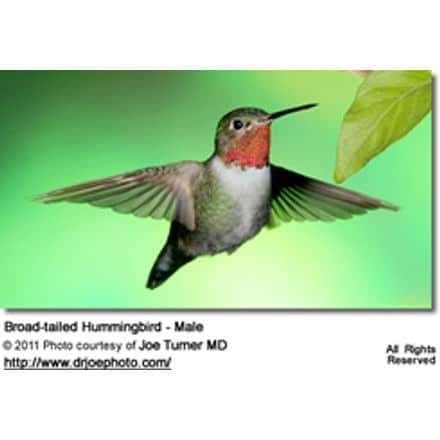
Anna’s Hummingbirds (Calypte anna) – Accidental / Vagrants
One of the larger and the most vocal hummingbirds in the United States, where it is the only species to produce a song; specifically the males produce a complex series of scratchy noises, sounding like a sharp “chee-chee-chee; when moving from flower to flower, they emit toneless “chip” vocalizations. All other hummingbirds in the United States are mostly silent.
They are well known for their territorial behavior; the male makes elaborate dive displays at other birds and sometimes even at people. At the bottom of their dives, they produce high-pitched loud popping sounds with their tail feathers.
Males have glossy dark rose-red throats and crowns, which may appear black or dark purple in low light. The underside is mostly greyish; and the back metallic green.
Females have light grey chests with white and red spotting on the throat, greenish back and white tipped tails.
They resemble the Costa’s Hummingbirds (not yet reported in this state), but the male’s Costa’s Hummingbird‘s gorget (throat feathers) is longer than that of the Anna’s. They are larger than the Rufous Hummingbirds and lack the rusty coloration of the Rufous Hummingbirds.
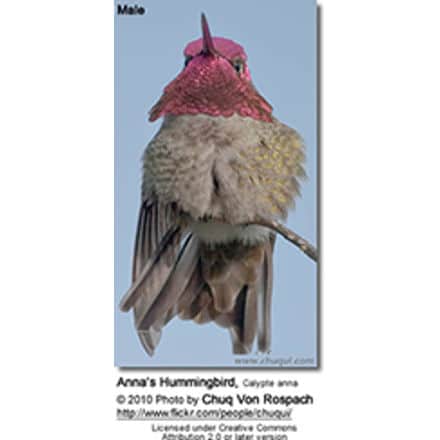
Allen’s Hummingbirds (Selasphorus sasin) – Rare vagrants – The Allen’s Hummingbird is often confused with the Rufous Hummingbird, but the Allen’s can be identified by the green back whereas the Rufous Hummingbird has a coppery back.
The male has a throat that ranges in color from orange-red to yellow-orange, a back that is bright green, a rump that is rufous and its tail feathers are rufous tipped in black.
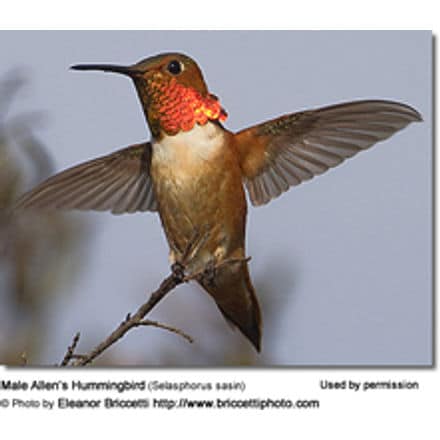
Black-chinned Hummingbirds, Archilochus alexandri – Rare in winter, spring, and fall in all regions. Found in open woodlands, parks and gardens
The male has a black, shimmering throat with a purple edge and pale feathers below that create a collar. However, unless the light is just right, the head looks all black. His back is green and there are some green feathers covering the chest.
The female is pale below (sometimes with a slightly speckled throat) and her back is green.

(Amazilia yucatanensis) – Accidental / Vagrants – Occur in fall, winter and spring
The male’s throat is a metallic golden green and the red, dark-tipped bill is straight and slender. Back and head are mostly metallic olive. The lower chest ranges in coloration to whitish with various shades of grey or green, or buffy (yellowish-brown).
The tail and primary wing feathers are rufous (reddish-brown) and slightly forked. The underwing is white.
The female is generally less colorful than the male and has a a dark upper bill
Broad-tailed Hummingbirds (Selasphorus platycercus). Accidental / Vagrant – Very Rare Winter Visitor – Occur in late fall, winter, and early spring, mainly in Gulf Coast region. gardens, along forest edges and at hummingbird feeders. The broad-tailed hummingbird lives in the Rocky Mountain states but occasionally comes as far to the east as Alabama and Georgia.
Males can most easily be identified by their iridescent, rose-red throats, white chest feathers and metallic green back and crown and their rounded tails. The males’ tails make whistling noises in flight.
Females lack the flashy throat patch of the male and are mostly pale below. Their white-tipped outer tail feathers are rust-colored close to the body and blackish in the center; the tail feathers in the center range from green to blackish.

Calliope Hummingbirds (Stellula calliope) – Accidental / Vagrants – Occur in late fall, winter and early spring in Gulf Coast, Inland Coastal Plain, as well as the Mountain regions.
The smallest breeding bird in North America.
They are most easily confused with the Rufous Hummingbirds and the Broad-tailed Hummingbird.
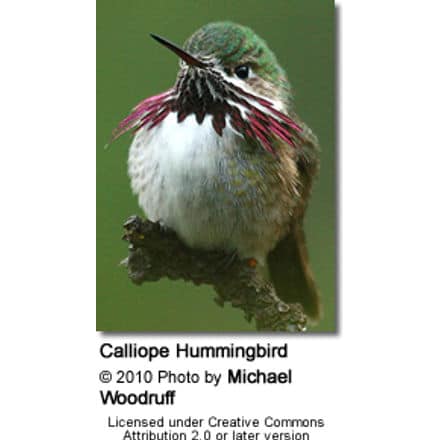
Green Violetear Hummingbirds (Colibri thalassinus) – Rare / Accidental – They are mostly resident in Mexico and Central America, but some seasonal movements have been observed. They may wander north to the United States and even as far north as Canada.
Green-breasted Mangos (Anthracothorax prevostii) – Accidental vagrants – These hummingbirds are native to Mexico, Central America down to Costa Rica, and some Caribbean islands. However, juveniles especially have been venturing into the United States. Several young birds have been sighted in Florida.
Adult Males are generally glossy bright green plumaged, more yellowish brown on its flanks (sides) and vent. There is a broad blue gorget (throat patch) that extends to below the chest – which may appear black in poor light conditions. Outer tail feathers range in color from an orangey-red to magenta or a deep purple tipped with black.
Females and Immature Birds: Outer tail feathers are broadly banded in magenta and iridescent dark blue. The outer 3 to 4 tail feathers are narrowly white tipped. The upper plumage is bronze-green. Below they are white with a dark central stripe that changes from black at the chin graduating to blue-green on the throat.
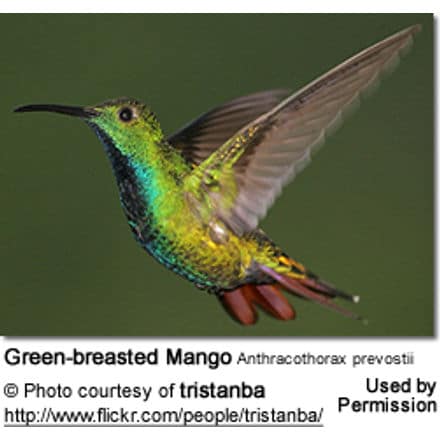
Is it a Hummingbird or an Insect?
The Hawk Moths (often referred to as “Hummingbird Moth”) is easily confused with hummingbirds, as they have similar feeding and swift flight patterns. These moths also hover in midair while they feed on nectar.
Moths have a couple of sensors or “antennas” on top of the head, which are key identifiers.


